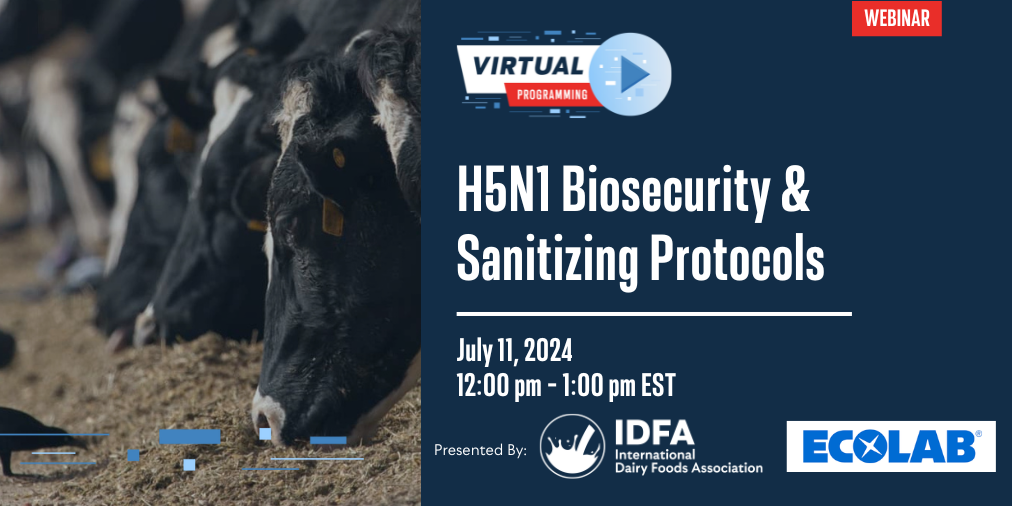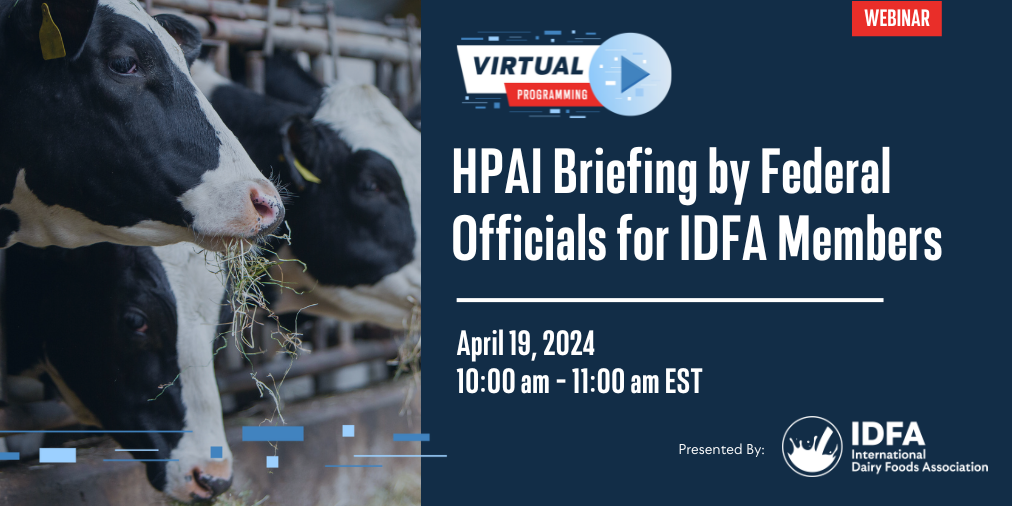As of Wednesday, Oct. 9, 2024, the U.S. Department of Agriculture (USDA) has confirmed highly pathogenic avian influenza (HPAI) in dairy herds in fourteen states. The confirmations were made via milk samples as well as nasal swabs and viral genome sequencing of the affected herds. USDA confirmed that the detections in dairy cows appear to have been introduced by wild birds; however, the Department continues to conduct an epidemiological investigation into how the virus is being transmitted among dairy herds and, so far, has no conclusive evidence. The latest USDA report on disease spread between dairy cattle farms found multiple direct and indirect transmission routes.
The USDA, CDC, and FDA continue to affirm that milk and dairy products remain safe to consume and the threat to the public remains low. On Monday, Sept. 30, the FDA and USDA co-signed letters to dairy processors and retailers emphasizing the confidence that the U.S. government has that pasteurization is effective in inactivating H5N1 in raw milk just as it is for pathogens against which we began pasteurizing raw milk 100 years ago. Pasteurization (high heat treatment) kills harmful pathogenic bacteria and other microorganisms, including viruses inclusive of HPAI. Routine testing and well-established protocols for U.S. dairy also continue to ensure that only safe milk enters the food supply.
The U.S. Centers for Disease Control and Prevention (CDC) has confirmed seventeen human cases of HPAI virus infection in the United States in 2024 that have been linked to dairy and poultry operations.
The latest news and resources from the coordinated U.S. government response to the illness is available here. More information related to milk and dairy safety, the virus, U.S. dairy biosecurity measures, workplace safety and protection, customer messaging, and more is located below.
Milk and Dairy Safety

According to federal officials, there are no expected impacts on the nation’s dairy supply at this time due to overlapping safeguards in place by U.S. dairy. Dairy markets and prices have been relatively unaffected to date. Consumers in the United States and around the world can remain confident in the safety and quality of U.S. dairy.
Pasteurization per the federal Grade “A” Pasteurized Milk Ordinance (PMO) kills harmful pathogenic bacteria and other microorganisms, including HPAI and other viruses. In April and May 2024, the FDA began releasing testing data affirming the effectiveness of pasteurization in destroying HPAI in retail milk and dairy samples. In August, FDA announced the results from the agency’s second survey of retail dairy products, which found all 167 samples to be negative for viable H5N1 virus. The data cited by FDA is consistent with many other studies demonstrating that the legally required temperature and time for milk pasteurization will readily inactivate HPAI. Viral fragments detected after pasteurization are nothing more than evidence that the virus is inactivated; they have zero impact on human health.
Moreover, the federal PMO prohibits milk from sick cows from entering the food supply chain. Sick or affected dairy cows are segregated on farms, as is normal practice with any animal health concern, and their milk does not enter the food supply. Additionally, USDA and FDA remind consumers that raw milk should not be consumed regardless of its availability. Raw milk is a key vehicle in the transmission of human pathogens, including E. coli O157:H7, Campylobacter, Listeria monocytogenes, and Salmonella, among others. As this situation continues to evolve, IDFA joins the USDA and FDA in strongly recommending that all raw milk and raw milk components be heat treated to a temperature and duration that kills harmful pathogenic bacteria and other microorganisms, including viruses inclusive of HPAI, regardless of the product’s intended use for human or animal consumption. FDA also recommends out of an abundance of caution that milk from cows in an affected herd not be used to produce raw milk cheeses.
More information from FDA can be found here.
Trade and Exports
IDFA is working with federal partners to ensure trading partners rely on the OIE-acknowledged, science-based food safety steps taken in U.S. dairy processing to preserve market access. There are no known disruptions or barriers to U.S. dairy trade and exports at this time.
Suggested Customer Messaging
Based on the available information from authorities, IDFA has crafted this message that IDFA members can use to communicate with customers about HPAI in dairy cattle.
The USDA, CDC, FDA, and state health authorities all have affirmed the safety of the U.S. commercial milk supply. The federal Grade “A” Pasteurized Milk Ordinance (PMO) is the global standard for milk safety, ensuring no milk from cows exposed to HPAI or other illnesses enters the food supply and should milk from any asymptomatic dairy cow enter a processing facility, pasteurization will destroy HPAI as well as other viruses and pathogens. In keeping with the PMO, milk from sick cows must be collected separately and is not allowed to enter the food supply. This means affected dairy cows are segregated, as is normal practice with any animal health concern, and their milk does not enter the food supply. Milk is then pasteurized (subjected to high heat treatment) to kill all harmful pathogenic bacteria and other microorganisms, including HPAI and other viruses. Viral fragments detected by lab tests following pasteurization are evidence that pasteurization has effectively destroyed HPAI; these fragments have no impact on human health. All pasteurized milk and dairy products are safe. More information about pasteurization and HPAI is available here.
About the Illness in Cows
Dairy producers with affected cows are reporting a rapid onset illness in herds, specifically among older, lactating cows. Clinical signs include:
- Decreased herd level milk production
- Acute sudden drop in production
- Decrease in feed consumption
- Abnormal feces and some fever
- Older cows are more likely to be impacted than younger cows
According to dairy farmers and veterinarians reporting on affected herds, most affected cows recover within 7-10 days.
Dairy farmers who observe clinical signs in their herd should immediately contact their veterinarian. Veterinarians who observe these clinical signs and have ruled out other diagnoses on a client’s farm should contact the state veterinarian and plan to submit a complete set of samples to be tested at a diagnostic laboratory. USDA has told the dairy community and practitioners that cattle are expected to fully recover in a few weeks and there is no need to cull dairy cows because HPAI poses a low risk to human health. While HPAI is fatal in about 90-100 percent of chickens, according to the CDC, there has been little to no mortality reported in dairy cows. Cows recover in about two weeks. Moreover, there are no widespread impacts on dairy production today. USDA will continue to share information as they learn more.
Enhanced Biosecurity Protocols Necessary on U.S. Dairy Farms
Dairy farmers must implement enhanced biosecurity protocols on their farms, limiting the amount of traffic into and out of their properties and restricting visits to employees and essential personnel. Avian influenza is an animal health issue, and the risk to humans remains low. However, as USDA advises, people with close or prolonged, unprotected exposures to infected birds or other animals (including livestock), or to environments contaminated by infected birds or other animals, are at greater risk of infection.
HPAI is transmitted through droppings or nasal discharge of infected birds, which can contaminate water, feed, dust, and soil. The virus may also be spread by wind. People can carry the virus on their shoes, clothes, equipment, and vehicles.
As a precaution, dairy farmers must take important steps to protect their operations and the milk supply. When handling any sick animal, people should take basic precautions to protect themselves. Wear gloves, avoid touching their eyes, nose, and mouth until washing their hands, remove clothing worn around sick animals to be washed, and shower at the end of the day.
The National Dairy FARM Program (NDFP) through the National Milk Producers Federation offers several valuable biosecurity resources as does USDA’s Animal and Plant Health Inspection Service (APHIS). On April 12, APHIS released recommendations for 1) State Animal Health Officials, Accredited Veterinarians and Producers, and 2) Workers. APHIS's Frequently Asked Questions document is available here.
In late August, IDFA along with National Milk Producers Federation, United Egg Producers, and the National Turkey Federation sent a joint letter to U.S. Department of Agriculture Secretary Tom Vilsack urging the support for development of safe and effective H5Nx vaccinations for dairy cows, turkeys and egg-laying hens. The availability of vaccinations would help mitigate the circulation of H5Nx in dairy herds and reduce the risk of spill-over HPAI into commercial turkey flocks and egg-laying operations. Read the full letter here.
Animal Movement Testing and Reporting Requirements
USDA has announced a number of actions to protect against the spread of HPAI in dairy cattle herds as well as other livestock populations. The first part of the USDA order requires testing and tracing of lactating dairy cattle for the purposes of interstate movement. Prior to interstate movement, for example, lactating dairy cattle are required to receive a negative test for Influenza A virus at an approved National Animal Health Laboratory Network (NAHLN) laboratory. USDA will cover the costs of the testing. These requirements may be applied to other classes of dairy cattle in the future as USDA learns more about the virus, but for today they apply to lactating dairy cattle only. The second part of the USDA order requires mandatory reporting by laboratories and state veterinarians of positive Influenza A nucleic acid detection diagnostic results (e.g. PCR or genetic sequencing) and/or serology diagnostic results in livestock, to USDA APHIS. Other components of this order are in the full USDA announcement. You may view the Federal Order, which is effective on Monday, April 29, 2024, here.
NCIMS, FDA and USDA Silo Study
Since the onset of the H5N1 outbreak in dairy cattle, researchers across the federal and state governments have been working to understand the prevalence of H5N1 in the U.S. milk supply. In October, states were invited to participate in a new study that will generate data to aid in the understanding of the prevalence of H5N1 in bulk raw cow’s milk received by dairy processing facilities across the nation. Dubbed “the silo study,” the information garnered from this research can help inform the national strategy to control the spread of the virus to other dairy cattle and avian flocks, and to identify any viral transformations. Learn more here.
Workforce Safety and Protection
IDFA recommends the following resources from the USDA and CDC to protect workers who are handling raw milk. According to CDC’s interim recommendations, people should avoid unprotected exposures to raw milk from animals with confirmed or suspected HPAI virus infection. When working with raw milk, employees should wear personal protective equipment (PPE) such as an NIOSH Approved® particulate respirator (for example an N95® or greater filtering facepiece respirator, elastomeric half mask respirator with a minimum of N95 filters), eye protection, and gloves, and perform thorough hand washing after contact with raw milk. Appropriate PPE depends on the hazards present and a site-specific risk assessment.
Workers should receive training on and demonstrate an understanding of:
- When to use PPE
- What PPE is necessary
- How to properly put on, use, take off, dispose and maintain PPE
- PPE limitations
Resources
- APHIS Recommendations for HPAI Virus in Livestock – Workers, USDA
- Protect Yourself From H5N1 When Working With Farm Animals, CDC
- HPAI Virus in Animals: Interim Recommendations for Prevention, Monitoring, and Public Health Investigations, CDC
- Recommendations for Worker Protection and Use of PPE to Reduce Exposure to Novel Influenza A Viruses (English and Spanish), CDC
- Updated Interim Recommendations for Worker Protection and Use of Personal Protective Equipment (PPE) to Reduce Exposure to Novel Influenza A Viruses Associated with Disease in Humans
- Registered Antimicrobial Products Effective Against Avian Influenza
- Fact Sheet: HPAI Prevention for Workers in Meat and Dairy Processing (Wisconsin Department of Health Services)
What is Avian Influenza?
Detections of avian influenza in birds, including chickens, are common in the United States in the spring and fall due to wild birds spreading the virus as they migrate to and from their seasonal homes.
While it is uncommon for Highly Pathogenic Avian Influenza to affect dairy cows, USDA APHIS has been tracking detections of HPAI in mammals for many years in the United States, leading dairy farmers and veterinarians in the United States to prepare for this eventuality.
Initial testing by the National Veterinary Services Laboratories has not found changes to the HPAI virus in dairy cattle that would make it more transmissible to humans. The risk to humans remains low. For more information about HPAI, visit the website of the American Veterinary Medical Association, or AVMA.
Public Information on Genetic Sequencing in People and Animals
U.S. federal agencies and international bodies are making publicly available genetic sequencing information in samples associated with the ongoing HPAI outbreak in dairy cattle, as well as the one individual from Texas confirmed with HPAI. Access these reports and updates here:
Government & Industry Resources
Additional IDFA Resources
H5N1 Biosecurity & Sanitizing Protocols

IDFA presented an informative webinar where Ecolab's subject matter experts shared the latest biosecurity best practices for managing risks presented by H5N1 in dairy farm and processing operations.
HPAI Briefing by Federal Officials for IDFA Members

IDFA hosted a briefing by federal government officials on the highly pathogenic avian influenza outbreak affecting dairy herds in several U.S. states.
IDFA members had an opportunity to ask questions via Zoom’s chat feature in the second half of the webinar.
News Releases
- 3/25/2024 - Unified Dairy Statement
- 3/25/2024 - Member Communication - IDFA: USDA, CDC, and FDA Confirm Avian Influenza in Texas and Kansas Herds, No Threat to Human Health
- 3/29/2024 - Member Communication - IDFA: USDA Confirms Avian Influenza in One Additional Dairy Herd in Michigan, No Threat to Human Health
- 4/1/2024 - Member Communication - IDFA: CDC Confirms H5N1 Avian Influenza in One Person in Texas, Risk to Human Health Remains Low; USDA Confirms Additional HPAI Cases in Dairy Herds in NM and TX, Pasteurized Milk and Dairy Safe for Consumers
- 4/11/2024 - Member Communication - IDFA: USDA Confirms HPAI Cases in Dairy Herds in NC and SD; Pasteurized Milk and Dairy Remain Safe for Consumers
- 04/23/2024 - Member Communication - IDFA: FDA Reaffirms that Pasteurization Is Effective Against HPAI, Commercial Milk Supply Safe
- 04/26/2024 - Member Communication - IDFA: Stay Up-To-Date on HPAI with IDFA Resource Page
- 04/26/2024 - Member Communication - IDFA: FDA Reports Significant Results Showing Pasteurization is Effectively Inactivating HPAI in Milk
- 05/01/2024 - Member Communication - IDFA: FDA Releases Additional Data Further Confirming Pasteurization Inactivates HPAI in Milk
- 05/20/2024 - Member Communication - Membership Update: FDA Releases New Details on HPAI Testing of Dairy Product Samples
- 05/22/2024 - Member Communication - HPAI Update: Michigan Department of Health and Human Services Announces 1 Human Case of H5N1
